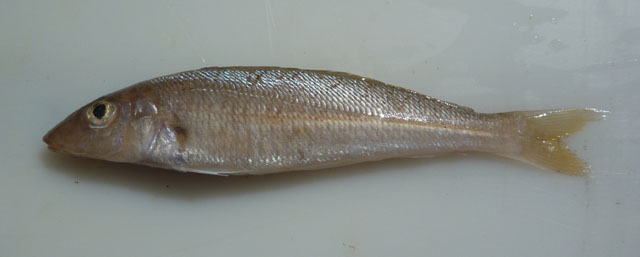| Sillaginidae (Smelt-whitings) |
| 33 cm SL (male/unsexed) |
|
demersal; marine; depth range 1 - 60 m, oceanodromous |
| Eastern Indian Ocean: Endemic to southern regions of the Australian continental shelf. Distribution ranges from Kangaroo Island in South Australia (Ref. 27573) to Geraldton in Western Australia (Ref. 6335). Report from Western Victoria (Ref. 6205) is erroneous (Ref. 6390). Not yet recorded from western Tasmania. |
|
Dorsal spines (total): 11-13; Dorsal soft rays (total): 18-19; Anal spines: 2-2; Anal soft rays: 18-20; Vertebrae: 33-35. No dark spot at the base of the pectoral fin; a series of oblique broken rusty brown bars on the back and upper sides, without a longitudinal row of rusty brown blotches along the midlateral silver stripe. |
| Live close to the sea bed over sandy substrates. Occur in the surf zone of beaches and quiet waters of bays and sandbanks. Are trawled in offshore waters to at least 55 m and possibly deeper. Juveniles may be found in shallow water off white sand beaches, together with accumulations of dead seaweed in the surf zone during spring and summer in Western Australia. Move into shallow waters in large schools during full moon (Ref. 6205). Feed mainly on crustaceans, amphipods, decapods, mysids and copepods. Juveniles consume mostly copepods (Ref. 6223). Oviparous (Ref. 205), and are multiple spawners with asynchronous development (Ref. 12343). |
|
Not Evaluated (N.E.) Ref. (130435)
|
| harmless |
Source and more info: www.fishbase.org. For personal, classroom, and other internal use only. Not for publication.

